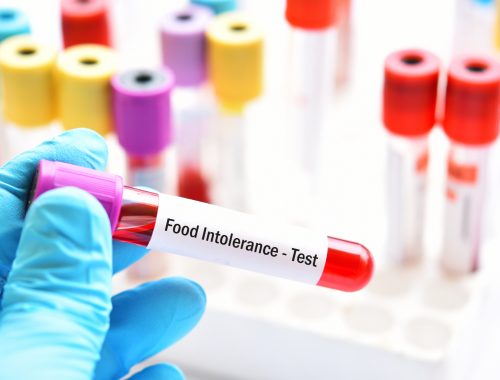Difference Between Food Allergies and Food Intolerances
A food allergy is when the body’s immune system recognizes a certain type of food as an invader and acts against it causing an allergic reaction. Food intolerance occurs when the body is unable to digest certain food and instead the food particles are irritating the gut lining.

What is a food allergy?
Definition:
A food allergy is when the body’s immune system recognizes a certain type of food as an invader and acts against it causing an allergic reaction.
Onset:
In food allergies, the symptoms appear within hours of eating food. The onset of symptoms is quick.
Symptoms:
Food allergy presents as anaphylaxis. The symptoms of food allergy include skin rash, urticaria, nausea, vomiting, abdominal pain, chest tightness, coughing, dyspnea, hypotension, and hoarseness.
Examples:
Common food allergies include allergies to milk, peanuts, wheat, fish, shellfish, and eggs. Food allergies are relatively common in children.
Effect:
Food allergies are dangerous. They often cause a severe life-threatening reaction known as an anaphylactic shock, within minutes of the allergen intake.
Treatment:
Injectable epinephrine is needed to tame anaphylaxis in food allergies.

What is food intolerance?
Definition:
Food intolerance occurs when the body is unable to digest certain food and instead the food particles are irritating the gut lining.
Onset:
The symptoms of food intolerance take time to emerge. The onset of symptoms is late and not as quick as in food allergies.
Symptoms:
The symptoms of food intolerance include intestinal gas, bloating, abdominal pain, and diarrhea.
Examples:
Common food triggers of food intolerance include beans, wheat, rye, barley, dairy products, cabbage, citrus fruits, and processed meat.
Effect:
Food intolerance presents as a mild set of symptoms, which are rarely life-threatening.
Treatment:
The treatment for food intolerance is the avoidance of the food trigger, for example, avoiding milk in case of lactose intolerance, and using lactose-free milk instead.
Difference between Food allergies and Food intolerances
Definition:
A food allergy is when the body’s immune system recognizes a certain type of food as an invader and acts against it causing an allergic reaction. Food intolerance occurs when the body is unable to digest certain food and instead the food particles are irritating the gut lining.
Onset:
In food allergies, the symptoms appear within hours of eating food. The onset of symptoms is quick. The symptoms of food intolerance take time to emerge. The onset of symptoms is late and not as quick as in food allergies.
Symptoms:
Food allergy presents as anaphylaxis. The symptoms of food allergy include skin rash, urticaria, nausea, vomiting, abdominal pain, chest tightness, coughing, dyspnea, hypotension, and hoarseness. The symptoms of food intolerance include intestinal gas, bloating, abdominal pain, and diarrhea.
Examples:
Common food allergies include allergies to milk, peanuts, wheat, fish, shellfish, and eggs. Food allergies are relatively common in children. Common food triggers of food intolerance include beans, wheat, rye, barley, dairy products, cabbage, citrus fruits, and processed meat.
Effect:
Food allergies are dangerous. They often cause a severe life-threatening reaction known as an anaphylactic shock, within minutes of the allergen intake.
Food intolerance presents as a mild set of symptoms, which are rarely life-threatening.
Treatment:
Injectable epinephrine is needed to tame anaphylaxis in food allergies. The treatment for food intolerance is the avoidance of food triggers.
Table of differences between Food allergies and Food intolerances

FAQs
Can food intolerances develop into food allergies?
It is very unlikely for food intolerance to develop into food allergy.
How do the symptoms of food allergies and food intolerances differ?
The symptoms of food allergies are quick to appear and include skin rash, urticaria, nausea, vomiting, abdominal pain, chest tightness, coughing, dyspnea, hypotension, and hoarseness. The symptoms of food intolerance include intestinal gas, bloating, abdominal pain, and diarrhea.
Are food allergies or food intolerances more common?
Food intolerance is more common than food allergies.
How are food allergies and food intolerances diagnosed?
These conditions are diagnosed via a blood test for antibodies and a skin prick test.
Can food allergies and food intolerances be prevented?
Yes, by avoidance of the food triggers.
Are there any long-term health consequences associated with food allergies or food intolerances?
Long-term health consequences of food allergies and food intolerances are irritable bowel syndrome, oral ulcers, fatigue, hives, and headache.
Can you outgrow a food allergy or food intolerance?
Yes, if developed in childhood, a person can outgrow a food allergy or intolerance by adulthood.
- Differences Between Reptiles and Amphibians - May 17, 2024
- Difference Between Ophthalmology and Optometry - May 15, 2024
- Difference Between Fear and Anxiety - April 2, 2024
Search DifferenceBetween.net :
Leave a Response
References :
[0]Turnbull, J. L., H. N. Adams, and David A. Gorard. "The diagnosis and management of food allergy and food intolerances." Alimentary pharmacology & therapeutics 41.1 (2015): 3-25.
[1]Zopf, Yurdagül, et al. "The differential diagnosis of food intolerance." Deutsches Ärzteblatt International 106.21 (2009): 359.
[2]Ortolani, Claudio, and Elide A. Pastorello. "Food allergies and food intolerances." Best Practice & Research Clinical Gastroenterology 20.3 (2006): 467-483.
